1996 CHEVROLET CORVETTE change wheel
[x] Cancel search: change wheelPage 197 of 386
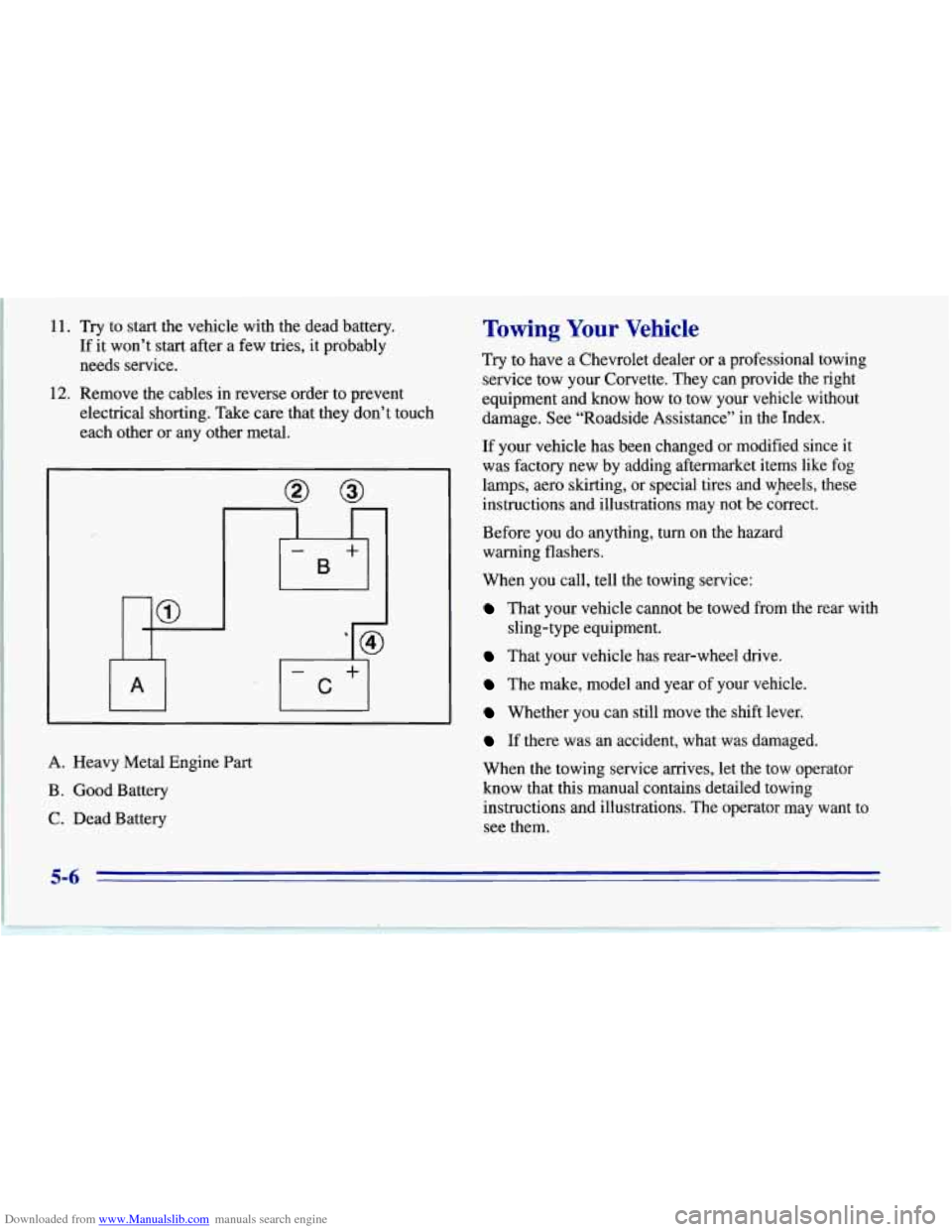
Downloaded from www.Manualslib.com manuals search engine 11. Try to start the vehicle with the dead battery.
If it won’t start after a few tries, it probably
needs service.
12. Remove the cables in reverse order to prevent
electrical shorting. Take care that they don’t touch
each other or any other metal.
I
AI
A. Heavy Metal Engine Part
B. Good Battery
C. Dead Battery
Towing Your Vehicle
Try to have a Chevrolet dealer or a professional towing
service tow your Corvette. They can provide the right
equipment and know how to tow your vehicle without
damage. See “Roadside Assistance” in the Index.
If your vehicle has been changed or modified since it
was factory new by adding aftermarket items like fog
lamps, aero skirting, or special tires and wbeels, these
instructions and illustrations may not be cbrrect.
Before you do anything, turn on the hazard
warning flashers.
When you call, tell the towing service:
That your vehicle cannot be towed from the rear with
That your vehicle has rear-wheel drive.
The make, model and year of your vehicle.
Whether you can still move the shift lever.
If there was an accident, what was damaged.
When the towing service arrives, let the tow operator
know that this manual contains detailed towing
instructions and illustrations. The operator may want to
see them.
sling-type equipment.
5-6
Page 213 of 386
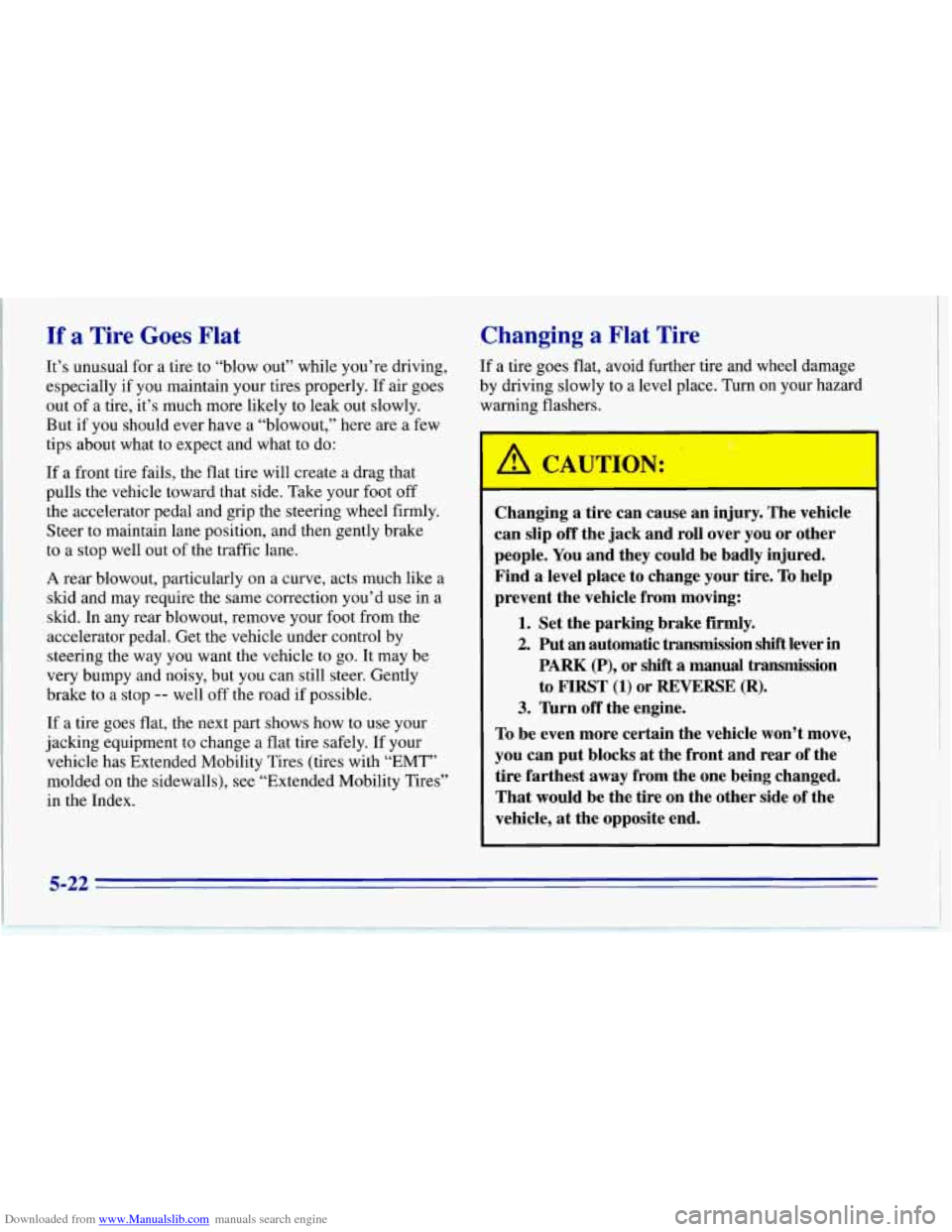
Downloaded from www.Manualslib.com manuals search engine If a Tire Goes Flat
It’s unusual for a tire to “blow out’’ while you’re driving,
especially if you maintain your tires properly. If air goes
out of a tire, it’s much more likely to leak out slowly.
But if you should ever have a “blowout,” here are a few
tips about what to expect and what to do:
If a front tire fails, the flat tire will create a drag that
pulls the vehicle toward that side. Take your foot
off
the accelerator pedal and grip the steering wheel firmly.
Steer to maintain lane position, and then gently brake
to
a stop well out of the traffic lane.
A rear blowout, particularly on a curve, acts much like a
skid and may require the same correction you’d use in a
skid. In any rear blowout, remove your foot from the
accelerator pedal. Get
the vehicle under control by
steering the way you want the vehicle to go. It may be
very bumpy and noisy, but you can still steer. Gently
brake to a stop
-- well off the road if possible.
If
a tire goes flat, the next part shows how to use your
jacking equipment to change a flat tire safely. If your
vehicle has Extended Mobility Tires (tires with
“EMT”
molded on the sidewalls), see “Extended Mobility Tires”
in the Index.
.Changing a Flat Tire
If a tire goes flat, avoid further tire and wheel damage
by driving slowly to a level place. Turn on your hazard
warning flashers.
A CAUTION:
3
Changing a tire can cause an injury. The vehicle
can slip off the jack and roll over you or other
people. You and they could be badly injured.
Find
a level place to change your tire. To help
prevent the vehicle from moving:
1. Set the parking brake firmly.
2. Put an automatic transmission shift lever in
PARK (P), or shift a manual transmission
to
FIRST (1) or REVERSE (R).
3. lbrn off the engine.
To
be even more certain the vehicle won’t move,
you can put blocks at the front and rear of the
tire farthest away from the one being changed.
That would be the tire on the other side of the
vehicle, at the opposite end.
Page 214 of 386
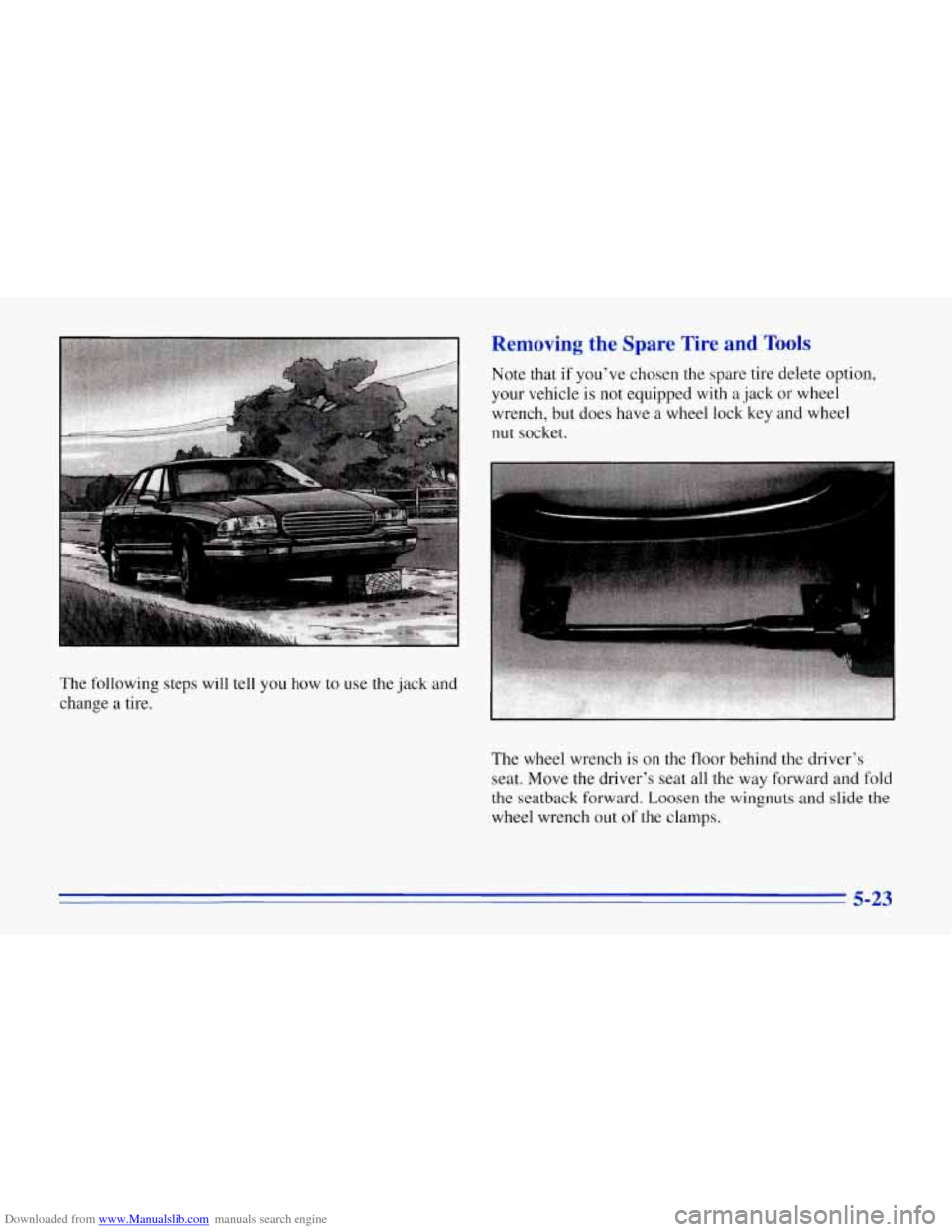
Downloaded from www.Manualslib.com manuals search engine The following steps will tell you how to use the jack and
change
a tire.
Removing the Spare Tire and Tools
Note that if you've chosen the spare tire delete option,
your vehicle is not equipped with
a jack or wheel
wrench, but does have a wheel lock key and wheel
nut socket.
The wheel wrench is on the
floor behind the driver's
seat. Move the driver's
seat all the way forward and fold
the seatback forward. Loosen the wingnuts and slide the
wheel wrench out
of the clamps.
5-23
Page 222 of 386
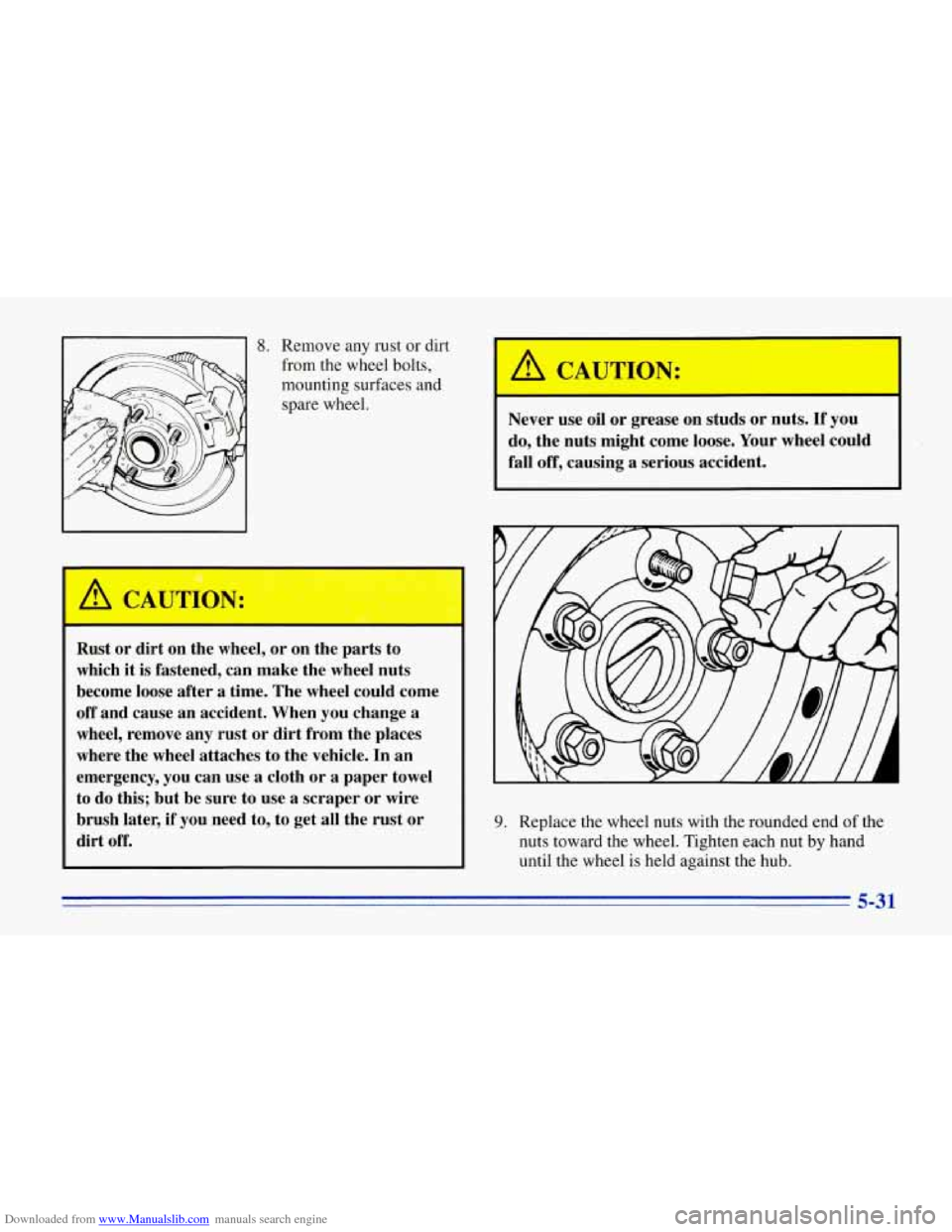
Downloaded from www.Manualslib.com manuals search engine 8. Remove any rust or dirt
from the wheel bolts,
mounting surfaces and
spare wheel.
Rust or dirt on the wheel, or on the parts to
which it is fastened, can make the wheel nuts
become loose after a time. The wheel could come
off and cause an accident. When you change a
wheel, remove any rust or dirt from the places
where the wheel attaches to the vehicle. In an
emergency, you can use
a cloth or a paper towel
to do this; but be sure to use
a scraper or wire
brush later, if you need to, to get all the rust or
dirt off.
A CAUTION.
Never use oil or grease on studs or nuts. If you
do, the nuts might come loose. Your wheel could
fall
off, causing a.serious accident.
9. Replace the wheel nuts with the rounded end of the
nuts toward the wheel. Tighten each nut
by hand
until the wheel
is held against the hub.
5-31
Page 279 of 386
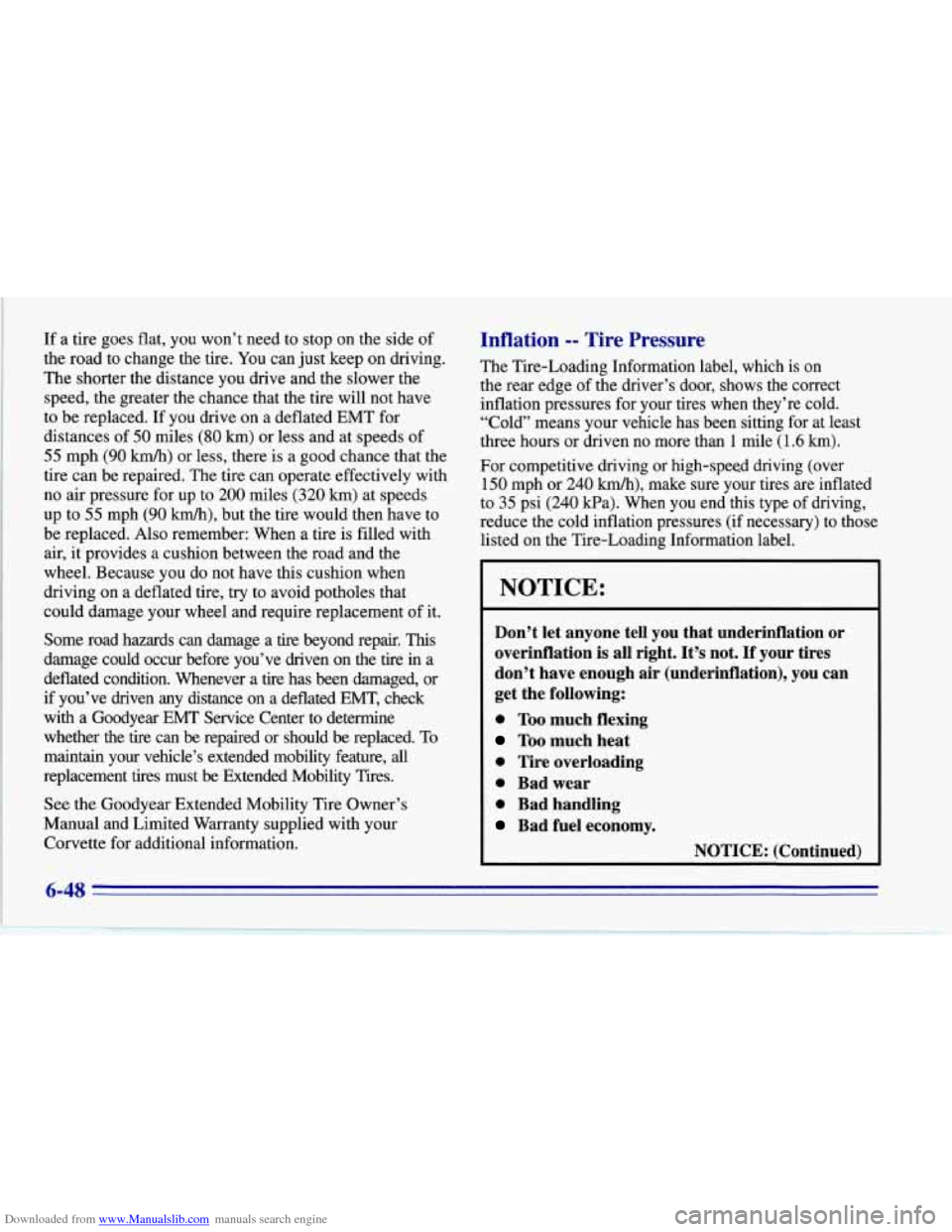
Downloaded from www.Manualslib.com manuals search engine If a tire goes flat, you won’t need to stop on the side of
the road to change the tire.
You can just keep on driving.
The shorter the distance you drive and the slower the
speed, the greater the chance that the tire will not have
to be replaced. If you drive on a deflated EMT for
distances of
50 miles (80 km) or less and at speeds of
55 mph (90 km/h) or less, there is a good chance that the
tire can be repaired. The tire can operate effectively with
no air pressure for up to 200 miles (320 km) at speeds
up to
55 mph (90 km/h), but the tire would then have to
be replaced. Also remember: When a tire is filled with
air, it provides a cushion between the road and the
wheel. Because you do not have this cushion when
driving on a deflated tire, try to avoid potholes that
could damage your wheel and require replacement of it.
Some road hazards can damage a
tire beyond repair. This
damage could occur before you’ve driven on the tire in a
deflated condition. Whenever a tire has been damaged, or
if you’ve driven any distance on a deflated
EMT, check
with a Goodyear EMT Service Center to determine
whether the tire can be repaired or should be replaced. To
maintain your vehicle’s extended mobility feature,
all
replacement tires must be Extended Mobility Tires.
See the Goodyear Extended Mobility Tire Owner’s
Manual and Limited Warranty supplied with your
Corvette for additional information.
Inflation -- Tire Pressure
The Tire-Loading Information label, which is on
the rear edge of the driver’s door, shows the correct
inflation pressures for your tires when they’re cold.
“Cold” means your vehicle has been sitting for at least
three hours or driven no more than
1 mile (1.6 km).
For competitive driving or high-speed driving (over
150 mph or 240 km/h), make sure your tires are inflated
to 35 psi
(240 kPa). When you end this type of driving,
reduce the cold inflation pressures (if necessary) to those
listed on the Tire-Loading Information label.
I NOTICE:
Don’t let anyone tell you that underinflation or
overinflation is all right. It’s not. If your tires
don’t have enough air (underinflation), you can get the following:
0 Too much flexing
Too much heat
0 Tire overloading
0 Bad wear
0 Bad handling
Bad fuel economy.
NOTICE: (Continued)
Page 384 of 386
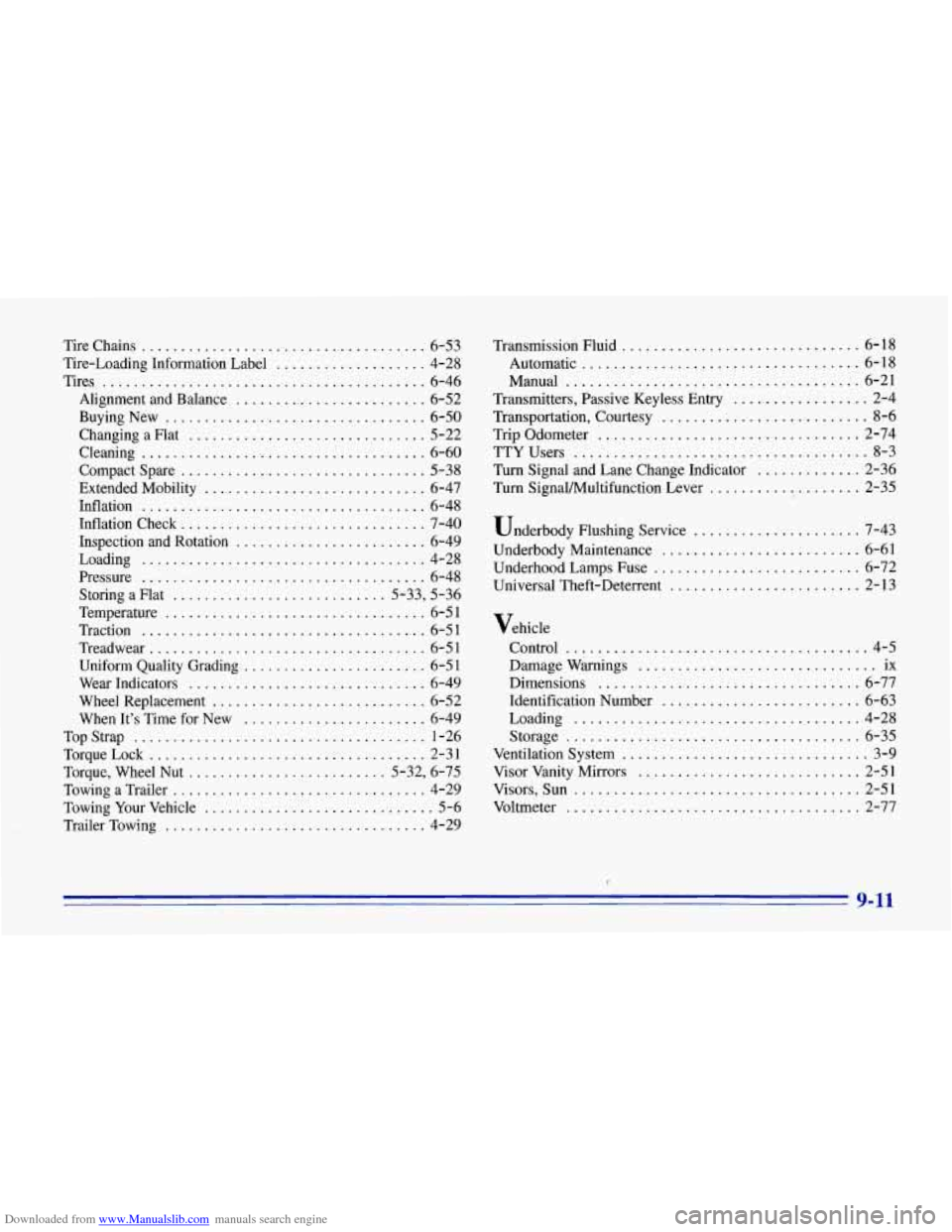
Downloaded from www.Manualslib.com manuals search engine Tire Chains .................................. 6-53
Tire-Loading Information Label
................... 4-28
Tires
......................................... 6-46
Alignment and Balance
........................ 6-52
BuyingNew
................................. 6-50
Changing a Flat
.............................. 5-22
Cleaning
.................................... 6-60
Compact Spare
............................... 5-38
Extended Mobility
............................ 6-47
Inflation
.................................... 6-48
Inflation Check
............................... 7-40
Inspection and Rotation
........................ 6-49
Loading
.................................... 4-28
Pressure
.................................... 6-48
Storing a Flat
........................... 5-33, 5-36
Temperature
................................. 6-5 1
Traction .................................... 6-51
Treadwe
ar ................................... 6-51
Uniform Quality Grading
....................... 6-51
Wear Indicators
.............................. 6-49
Wheel Replacement
........................... 6-52
When It’s Time for New
....................... 6-49
TorqueLock
................................... 2-31
Torque, Wheel Nut
......................... 5-32, 6-75
Towing a Trailer
................................ 4-29
Towing Your Vehicle
............................. 5-6
Trailer Towing
............................... 4-29
TopStrap
..................................... 1-26 Transmission Fluid
.............................. 6-18
Automatic
................................... 6-18
Manual
..................................... 6-21
Transmitters. Passive Keyless Entry
................. 2-4
Transportation. Courtesy
.......................... 8-6
Trip Odometer
................................. 2-74
TTYUsers
..................................... 8-3
Turn Signal and Lane Change Indicator
............. 2-36
Turn Signalklultifunction Lever
................... 2-35
Underbody Flushing Service
..................... 7-43
Underbody Maintenance
......................... 6-61
Universal Theft-Deterrent
........................ 2-13
UnderhoodLampsFuse
.......................... 6-72
Vehicle Control
...................................... 4-5
Damage Warnings
.............................. ix
Dimensions
................................. 6-77
Identification Number
......................... 6-63
Loading
.................................... 4-28
Ventilation System
............................... 3-9
Visor Vanity
Mirrors ............................ 2-51
Visors, Sun
.................................... 2-51
Voltmeter
..................................... 2-77
Storage
..................................... 6-35
I
9-11